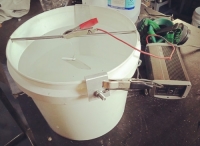A bit of anodising done today. One side was mirror polished, the other garnet blasted. I skipped the etching process to see if I could retain the shine, or at least some shine, no go. Nevertheless, it does provide a good finish for parts made of aluminium that don't need to be polished. My anodising setup is pretty basic: 10 litre plastic tub. Diluted sulfuric acid. Aluminium cathodes, aluminium wire and 10 amp battery charger. Before doing anymore I'll upgrade to lead cathodes, an ammeter and some titanium wire. I can also try a thinner anodise coating, if nothing else, it will give a lighter grey colour.
For the shiny parts, I investigated bright dipping, but the process is far to toxic and dangerous for me, and there are very few places that do it commercially, due to that.. So ,I'll give electro polishing a go instead. Not sure if oxidising is a problem after this procedure, information is a little sketchy in this area.


 LinkBack URL
LinkBack URL About LinkBacks
About LinkBacks


 Reply With Quote
Reply With Quote




Bookmarks